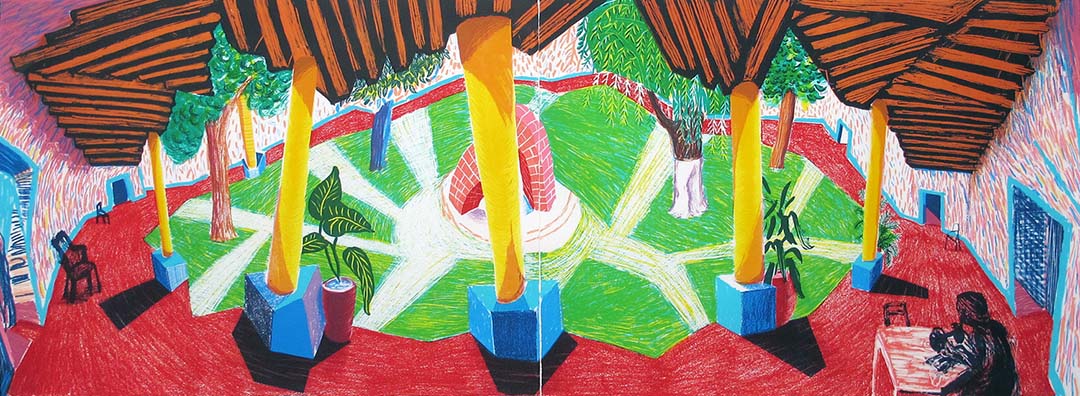The HOPA Collector’s Fine Art Print Guide

David Hockney – Hotel Acatlan
Limited edition fine art prints empower artists and collectors alike. The artist can make their artwork available to a larger pool of buyers. And fine art prints are attractive to collectors for their variety, beauty, affordability and investment potential. Limited editions can maintain and increase in worth over time.
To better understand how collectors often make acquisitions, and if you should collect limited editions yourself, we’ve put together this useful guide that answers common questions about Fine Art Print terminology. Please Enjoy!
Original Art vs Reproductions:
The two main categories of art prints are original art prints and reproductions. Reproductions can be mass-produced print copies, i.e. a giclèe of a famous work of art. Most often, reproductions are worth only so much. Original prints are usually made one-by-one, signed by the artist, and often, slight differences exist between prints within the edition that add value to the uniqueness of each art print.
What is a Limited Edition Print?
When artists create Limited Edition Prints of their work, there are two main ways to do this:
● Open Edition: In these editions, artists will print as many copies as they can sell using the same printing process (what is called an edition). Buyers never know how many will be printed, because the artist can continue to make more in this edition.
● Limited Edition: With limited editions, an artist will set a cap, the edition size, to how many they will print. This helps the individual prints hold and increase in value, because once the entire edition is printed, no more will be created. Scarcity rules. Some editions are quite low (say, 30 copies), while others can be in the thousands.
A limited edition print will be numbered and signed on the front or the back. If there are 50 in the edition, the first will be numbered 1/50, while the last will be numbered 50/50. In some cases, a limited edition won’t just be a reproduction of a work of art, but like sculptures or paintings, it will be an original, as well. This is often true for printmakers like Andy Warhol. Many factors come into play when value is determined: quality, condition, edition size, number, technique, signed or unsigned…and what collectors are prepared to pay.
Signed vs. Unsigned:
One of the first details in an acquisition that an experienced art collector looks for is the artist’s signature, usually located in the lower right hand corner and in pencil, as it is far more difficult to copy than an ink signature. The artist has clearly claimed ownership of the artwork by signing it, making the signature one of the most valuable factors in verification of authenticity. The value of a signed print is often over two times higher than an unsigned print, making them more desirable, expensive and investment worthy.
What are Trial Proofs (TP), Bon à Tirer Proofs (BAT), Artist Proofs (AP), Printers Proofs (PP), Exhibition Proofs (EP) and Hors d’ Commerce (HC) Proofs?
If you’ve looked at Limited Edition prints, you might have seen these terms:
● Trial Proofs: Throughout the printmaking process, the artist will be testing various ideas, colors, materials and techniques. The prints created during this process are called ‘trial proofs.’ They are sometimes incomplete and may only show a portion of the final print.
● Bon à Tirer Proofs (B.A.T.): Bon à Tirer, is a French term meaning ‘good to pull.’ The artist’s chosen finished plate is now ready to produce and the B.A.T. serves as the master print to match. As far back as the late 1800’s, an artist was required to write B.A.T. along with their signature to confirm that the atelier, the master printmaking studio, has the consent to produce the edition.
● Artist Proofs: These are prints from the edition pulled by the artist to keep or sell and usually are on the market shortly after the print is published. They will be labeled “AP” or “A/P” on the back. Some even have handwritten notes by the artist.
● Printers Proofs: These are similar to Artist Proofs. They are for the printer’s own use, often as part of their payment. They are typically the same value and quality as the regular edition.
● Exhibition Proofs: These are pulled by the artist specifically to send to galleries and museums for exhibitions. These prints are typically the same value and quality as the regular edition.
● Hors d’Commerce Proofs: (“not for sale”) are of a quality equal to the edition and are numbered “HC”. These are far more rare, often given to collaborators as gifts or as partial payment for their services.
What are the benefits of Limited Edition prints?
Limited edition prints are a great option for art buyers!
Because the print runs are capped, limited editions maintain scarcity. They will be able to hold and grow in value. In fact, some limited edition prints have sold in the seven and even eight-figure price range. One of Picasso’s first prints recently sold for over 2M USD!
Where can I find Limited Edition prints?
The art world can be a confusing place to find what you’re looking for. That’s where Henry on Pop Art can help! Henry makes finding Blue Chip Pop and Contemporary Art a smooth and enjoyable experience.
Consult the expert — Ask Henry



